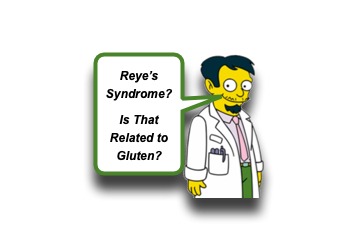Reye’s Syndrome

Call me crazy, but discussing Measles last week got me feeling nostalgic. Mumps, Tetanus, and Chicken Pox similarly harken back to the early days… you know, when safe and reliable vaccines didn’t exist. I distinctly remember having chicken pox personally (and my poor sister had them even worse!), but now you are more likely to see primary varicella in a book than on a child. Certainly, recent news has made it apparent that we still need to remain vigilant for these conditions. Let’s take a quick moment to recall another condition that was once more prevalent, but still demands our respect today – Reye’s Syndrome:
Reye’s Syndrome: Basics
- Reye’s Syndrome was first describe in 1963 (by, you guessed it, Reye et al.). [Reye, 1963]
- May occur at any age in childhood, although higher rates in children < 2 years of age.
- Currently it is rare, but can still be seen. [Noor, 2018]
- Death occurs in ~30-40% of cases due to brainstem dysfunction.
- Etiology is not clearly known.
- Possible that it isn’t due to one causative agent, but rather different mechanisms that have similar final results. [Schror, 2007]
- An association (although not clear causality) is described between recent viral illness and aspirin therapy.
- Reye’s Syndrome rates declined after warnings to avoid aspirin therapy in children. [CDC.gov]
- Reduced rates may also be due to better understanding of alternative diagnoses that present similarly. [Schror, 2007]
- Aspirin therapy is still reserved in children for specific conditions (ex, Kawasaki) rather than for fever management. [Schror, 2007]
- May be related to inducible Nitric Oxide synthase that is seen as a consequence of a variety of factors, including viral illness and aspirin therapy. [Clark, 2001]
- Presentation:
- Presents after a recent viral illness.
- Often a near recovery from antecedent illness is seen with dramatic worsening after a few days. [Ninove, 2011]
- Gastroenteritis, Varicella, and Influenza are classically described as being associated with Reye’s Syndrome.
- Patients develop acute:
- Vomiting
- Change in mental status (disorientation, loss of consciousness)
- Seizures
- May be found to have Hepatomegaly and Hypoglycemia.
- May have evidence of Cerebral Edema.
- Presents after a recent viral illness.
- Reye Syndrome is characterized by combination of: [Noor, 2018; Ninove, 2011; Gosalakkal, 2008]
- Acute Non-inflammatory encephalopathy
- If CSF is available, WBC count < 8
- If histology available, cerebral edema has no perivascular or meningeal inflammation
- Acute liver disease
- Fatty changes of the liver or
- 3 fold increase in ALT, AST or
- Hyperammonemia
- No other clear etiology for these findings.
- Acute Non-inflammatory encephalopathy
Reye-Like Syndrome
- Many other conditions can present similarly and mimic Reye Syndrome. [Gosalakkal, 2008]
- Inborn Errors of Metabolism
- Mitochondrial disorders
- Fatty-acid oxidation disorders
- Urea Cycle disorders
- Sepsis
- Viral Encephalitis
- Drug Overdose & Toxicity
- Trauma
- Inborn Errors of Metabolism
- Currently, because Reye’s Syndrome is rarely encountered, patients presenting with findings concerning for Reye’s Syndrome should have other conditions ruled out. [Gosalakkal, 2008]
Moral of the Morsel
- History seems to repeat itself. Stay vigilant even if a condition is rare now.
- Consider possible aspirin therapy in the altered patient. Change in mental status and hyperammonemia may be be more than liver disease.
- Inborn errors of metabolism are sneaky! Aspirin may not explain it all.
References
Noor A1, Gradidge E1,2. A Case of Reye Syndrome Caused by Influenza A Virus. Ochsner J. 2018 Winter;18(4):425-427. PMID: 30559633. [PubMed] [Read by QxMD]
Ninove L1, Daniel L, Gallou J, Cougard PA, Charpentier A, Viard L, Roquelaure B, Paquis-Flucklinger V, de Lamballerie X, Zandotti C, Charrel RN. Fatal case of Reye’s syndrome associated with H3N2 influenza virus infection and salicylate intake in a 12-year-old patient. Clin Microbiol Infect. 2011 Jan;17(1):95-7. PMID: 20167009. [PubMed] [Read by QxMD]
Gosalakkal JA1, Kamoji V. Reye syndrome and reye-like syndrome. Pediatr Neurol. 2008 Sep;39(3):198-200. PMID: 18725066. [PubMed] [Read by QxMD]
Schrör K1. Aspirin and Reye syndrome: a review of the evidence. Paediatr Drugs. 2007;9(3):195-204. PMID: 17523700. [PubMed] [Read by QxMD]
Clark I1, Whitten R, Molyneux M, Taylor T. Salicylates, nitric oxide, malaria, and Reye’s syndrome. Lancet. 2001 Feb 24;357(9256):625-7. PMID: 11558501. [PubMed] [Read by QxMD]
REYE RD, MORGAN G, BARAL J. ENCEPHALOPATHY AND FATTY DEGENERATION OF THE VISCERA. A DISEASE ENTITY IN CHILDHOOD. Lancet. 1963 Oct 12;2(7311):749-52. PMID: 14055046. [PubMed] [Read by QxMD]

